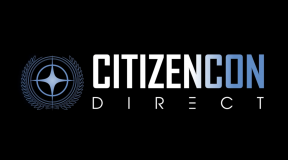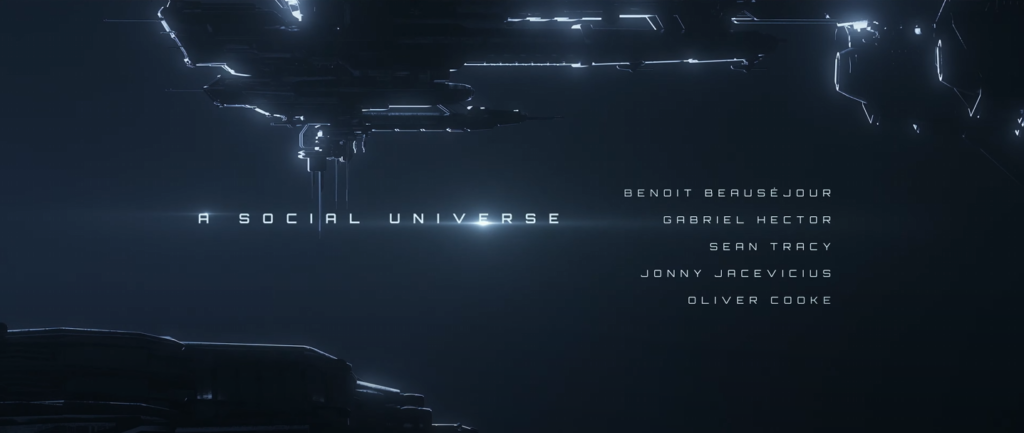
Sometimes even I forget that Star Citizen is an MMO. To me, MMO evokes often a fantasy setting, maybe a theme park but occasionally sandbox, and has a bare minimum set of features that facilitates player interaction. It’s that last point that I think deflects my consideration of Star Citizen as an MMO because the social features built into the current game are absolute shit.
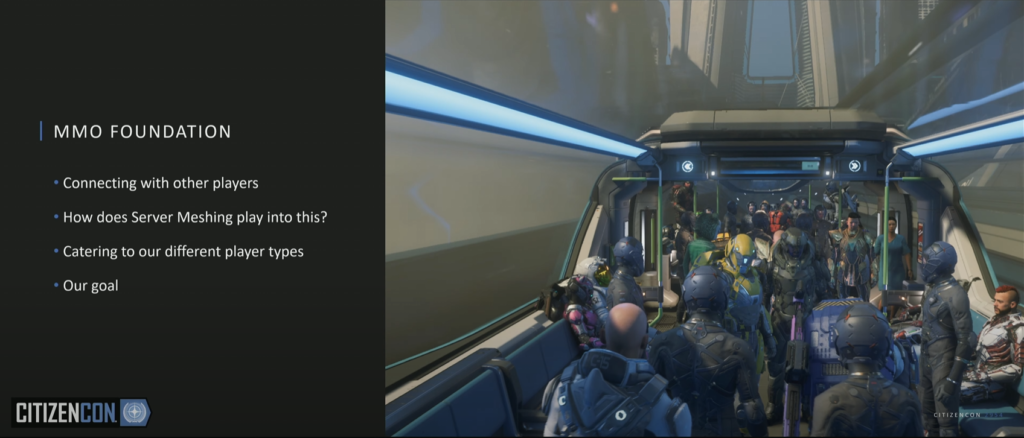
This is changing, though. The current live game only allows for about 100 people per shard, and that hardly puts the first “M” in “MMO”. Part of the upcoming 4.0 release is the addition (we hope) of “server meshing” which will allow players to seamlessly (we hope) move between shards that control different aspects of the game universe. While this will bring more players in contact with one another, it will also require that back-end tools like friends lists, communications, mission tracking, and org features expand beyond their current shard-centric focus to encompass everyone, everywhere…including to those players who are not currently in the game.
Tools
Player management is run through a UI called the MOBIGlass which is a holographic menu system projected from a wrist-worn computer. The MOBIGlass system currently includes a very weak set of social tools for shard-wide chat, limited party management, and a bit of VOIP control.
The new tools — currently in a very basic, minimally viable MMO standards product — are looking to make things more robust and actually useful to all players.
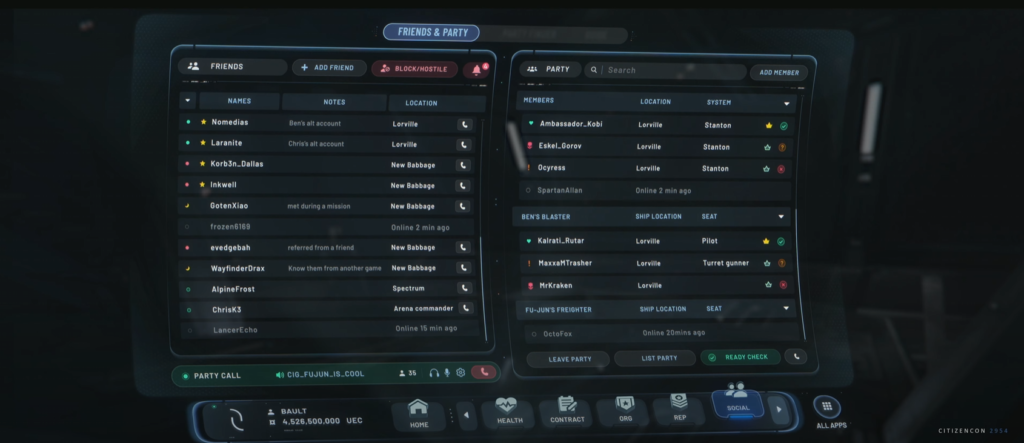
As stated during the presentation, the mock-ups in the presentation only represent the bare minimum that any MMO player would deem essential, so we’re talking about lists of names, online status, note fields, and current locations. We’re talking about party lists showing where the members are and who the leader is (although they also show which ship they might be in, and which console they might be sitting at which is kind of cool). There are block lists and even an institutionalized “KOS” list that we can maintain for ourselves.
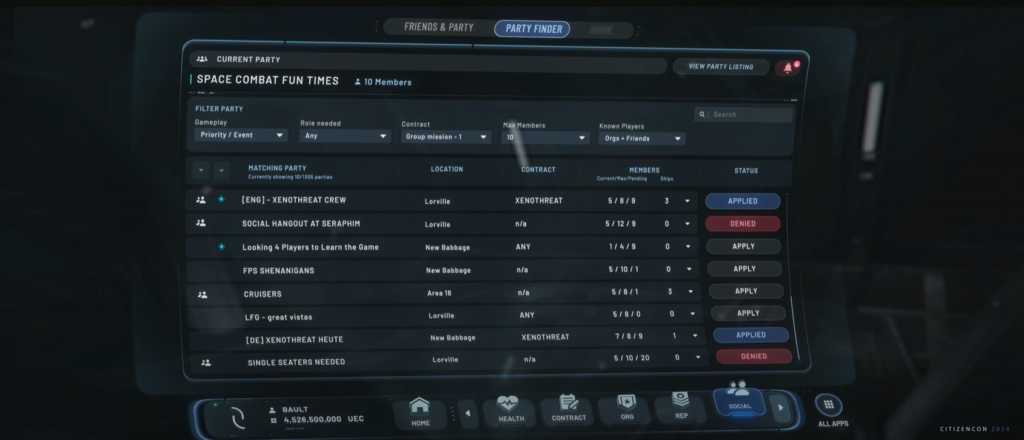
The new social system will include a party finder so that players can advertise custom LFG needs including where to meet up, what mission they’re doing (if any), and how many players they need, how many they have, and how many empty slots need to be filled.
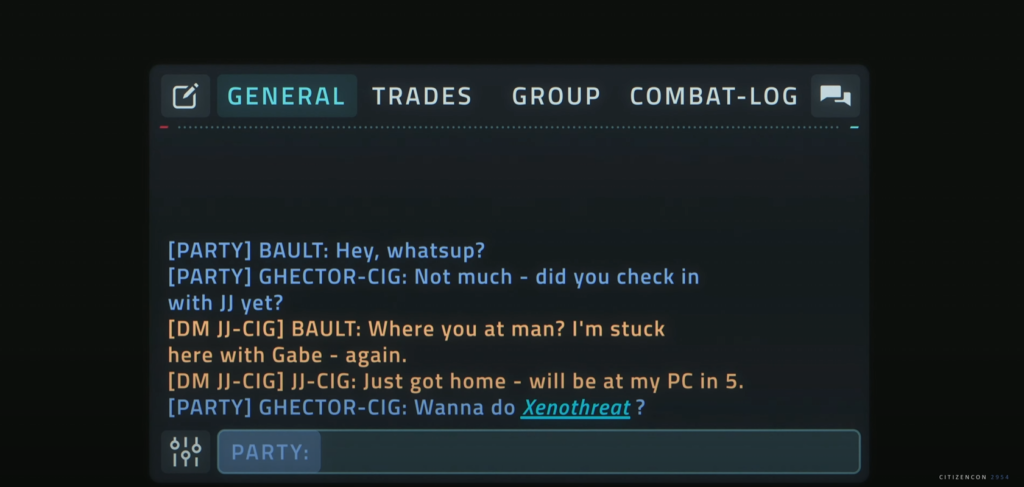
Chat is getting an upgrade. Right now chat is just a bunch of text on the side of the screen, so CIG is bringing things up to speed by providing a tried and true chat box implementation complete with tabs, filters, and linkable text. Player names, items, contracts, and locations can be linked and, in the case of the latter, will provide waypoints on the map, so that’s actually a very cool and useful feature assuming you don’t drop confidential location pins into General chat.
FOIP and VOIP
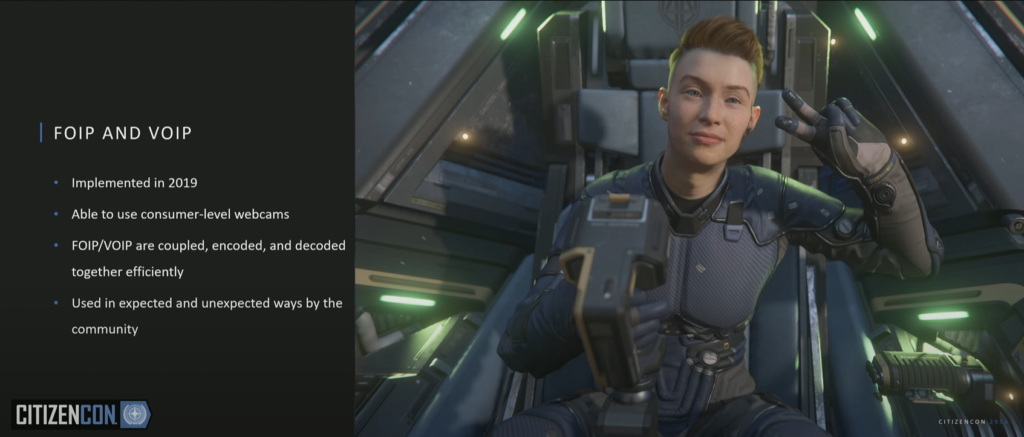
Almost as if developers refuse to acknowledge that Discord exists, Star Citizen has an in-game voice over IP (VOIP) system built in. The idea is admirable: players can “hail” one another and chat via in game voice. We can even use proximity VOIP to just talk to people standing next to us. I have one friend who uses it occasionally to talk to his neighbors, but honestly I have never really heard people in-game using it (I might actually have turned off incoming voice, though). Apparently the VOIP doesn’t work all that well all the time, so CIG is looking to shore up the quality and reliability of this system. They didn’t say, however, if they were going to make it more robust so that org or party channels could be better controlled for more organized operations.
Star Citizen also has face over IP (FOIP) which is a “nice to have” for most folks, but which as been a boon to machinima creators as all it requires is a basic webcam. While this also works 50% of the time 70% of time, CIG is going all-in on this and will be improving it alongside VOIP. For those who are really into character customization, FOPI updates will enhance the creation process as players can run their designs through FOIP to see how their facial constructs look with smiles, frowns, and other face-pulling expressions.
Guides
I want to slow down and focus a bit more on this part because I think it’s importing, telling, and rather unique.
Star Citizen is a complex project from a player perspective, as are sandbox games in general. I have heard people claim that they can’t play sandbox games because they need to have some kind of structure, lest they drift or fall prey to “analysis paralysis”. If we layer the complexities of Star Citizen on top of that, I can absolutely see how someone who is totally new to the game could get overwhelmed and frustrated. Depending on circumstances, people may rely on friends who have experience with the game to help them learn the ropes and put them on a path towards self-sufficiency and eventual success, but that’s not everyone despite what CIG seems to believe; some people will drop into the game as an unaffiliated solo player, with suitcase in hand and stars in their eyes, only to get mentally steamrolled the minute they lay eyes on the key bind map, just to pick on one aspect of the game.
That brings us to the guide system.
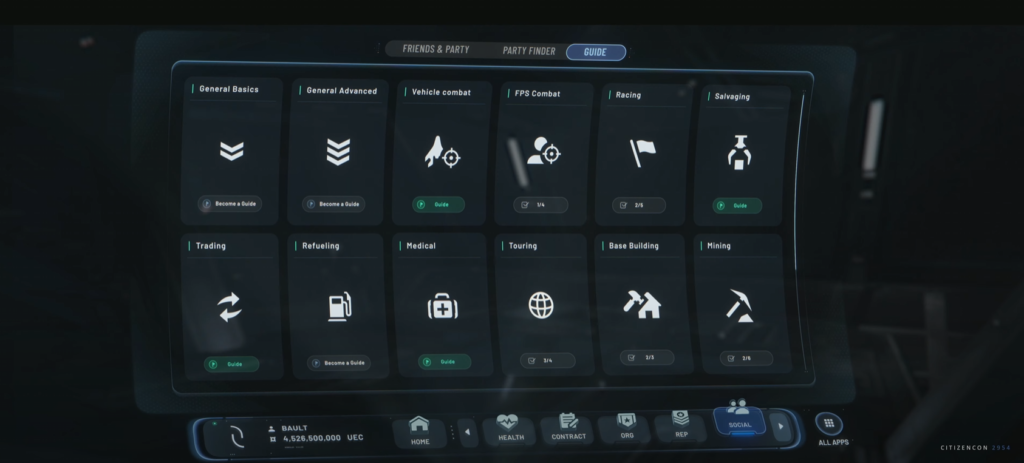
Currently, CIG offers a first-pass implementation of this through the website. Players who want to be (and/or qualify) can register as a guide for a particular topic like “beginner basics” or “vehicle combat” or “mining”. New players can contact those guides through the Spectrum social website, meet up in-game, and can learn how to tackle the desired mechanics. Admittedly, this directional flow is a bit cumbersome, as a player might not know what they want to learn until they are in the game…they might not even know about Spectrum. Bringing the guide system into the game itself is a Very Good Idea as it places it where players are when they decide they need it.
We need to acknowledge that Star Citizen, being an open-world game with open PvP, is prone to asshattery. “Beacons” exist in the game currently, and are designed to allow players to request assistance either with tough combat situations, or to request medical or operational help. Issuing a beacon costs the player aUEC which responders can receive when the issuer deems the help to have been successful. It shouldn’t take a lot of neurons to realize how this can be — and certainly is — exploited by griefers, so any guide system needs to do what it can to help avoid this.
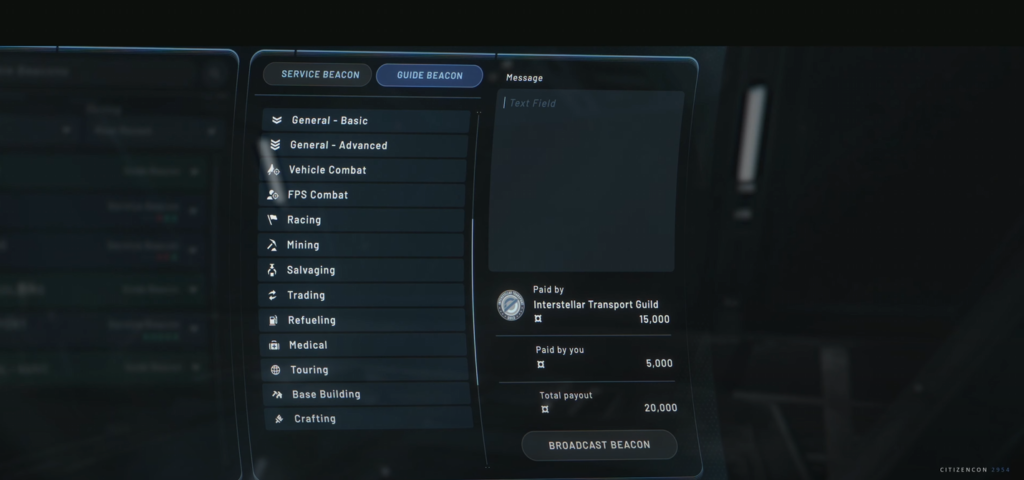
The new guide beacons will be paid for in part by a player’s chosen in-game guild (guilds are a complex subject, but know that they are not player organizations). This is an important thing to know as the behavior of the beacon issuer will reflect in their relationship with their current guild; bad behavior will result in a ratings downgrade and the player will lose privileges that a positive standing within a guild can offer (again, more on this later).
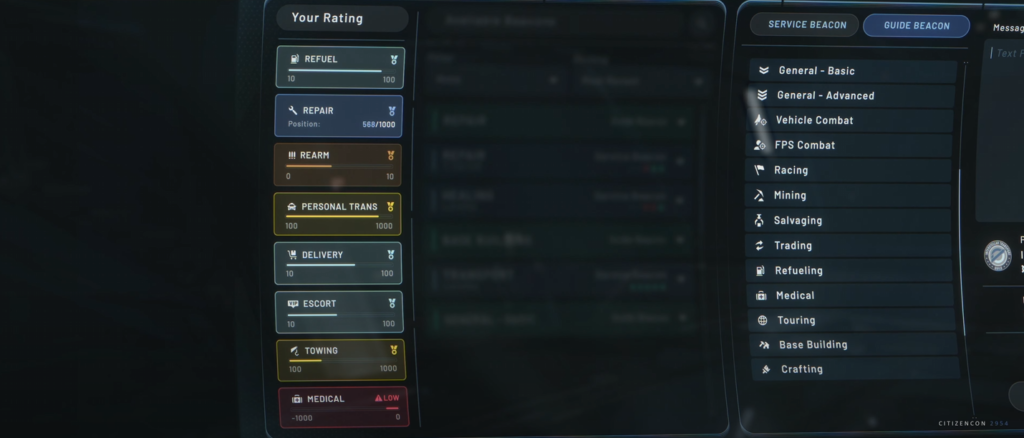
On the flip-side, like ride-sharing apps, individuals have ratings, and players can see their own ratings. Players who respond to well-meaning beacons with ill intent will get reported, and their ratings will go down. Before accepting a guide application, a new player will see the ratings of all responding players, and can accept one from this pool. The better a player’s rating, the more “trustworthy” they are, in theory.
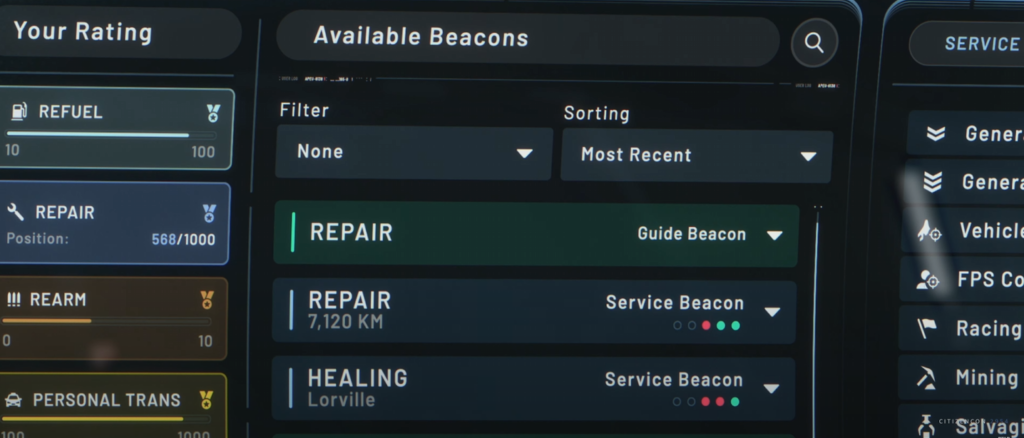
Finally, for those who might consider accepting a beacon, the panel which displays all currently active and unfilled beacons can see the type of beacon and the last five ratings of the player who issued the beacon. If a beacon lists five green dots, then it’s pretty safe to say that the issuing player is serious about their request; alternatively, any red dots means that the issuing player has unfavorable reviews, and one should exercise caution before agreeing to help.
Orgs, Factions, and Guilds
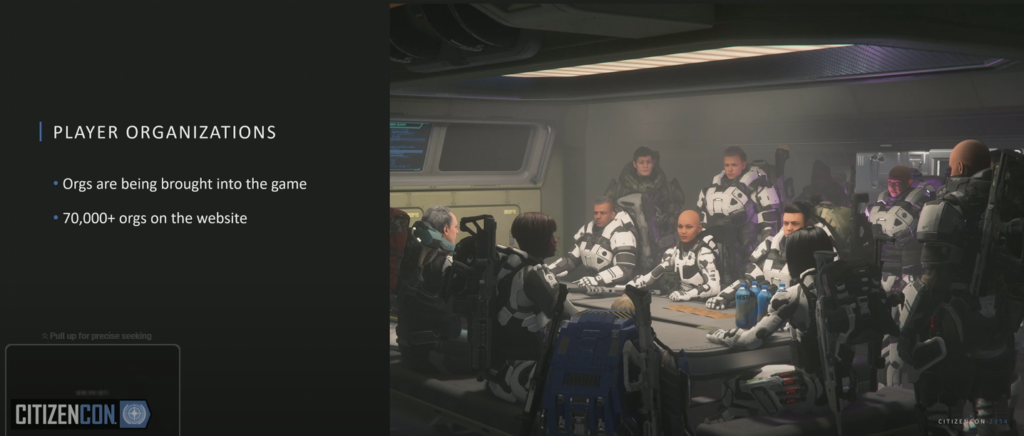
It’s easy to create an org in Star Citizen, and although the above slide lists 70,000+, I’d guess that the majority of them are one, two, or maybe a handful of players who are trying to make a larger group, or are just a bunch of friends who want a corner of the game to call their own. On the other hand, the org I belong to, Armored Expeditions, has 174 registered members (over 300 on Discord, though). There are orgs which have a hell of a lot more members than that (TEST Squadron has 23,068 registered members as of this writing!). Players can be a member of multiple guilds, although like in Guild Wars 2, can only represent a single guild at a time, and the choice of representation will have a bearing on the perks a player receives.
Orgs are planned to operate very much like how EVE Online’s corporations work — for better or worse — and seem to be designed as a social construct that allows like-minded players to have a readily available pool of others to join up with, as well as for providing in-game resources and access control.

Org recruitment, application, and decisions between the two are moving into the game. Players will be able to filter through the list of orgs based on criteria, and tags which indicate a guild’s self-designated area of focus.
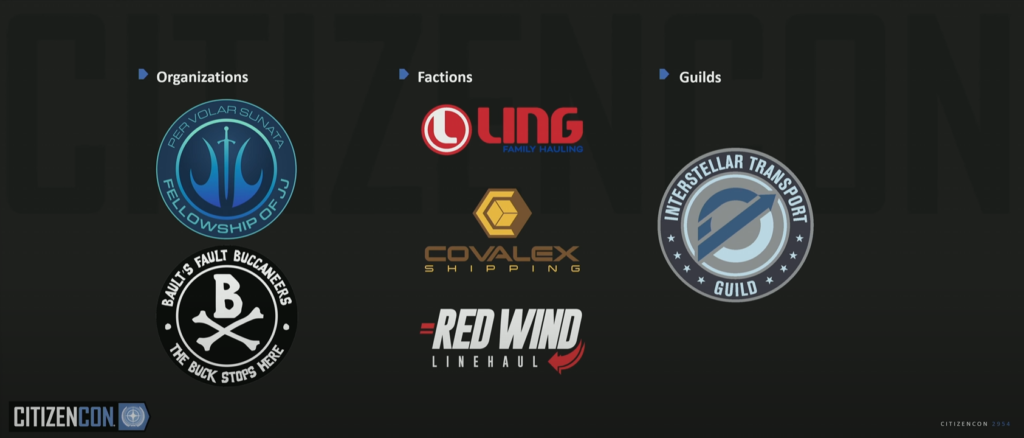
Unlike almost every other MMO out there, guilds in Star Citizen are lore-based organizations. They act as the source of missions that players can take, and also provide benefits through a reputation system. Guilds preside over factions which are distinct corporations, many of which are already in the game, and each of which has concerns centered in a specific category like bounty hunting, trade, or mining. We’ll see more about this structure in a future post and how it’s more than just layers of complexity for complexity’s sake.
Alignment
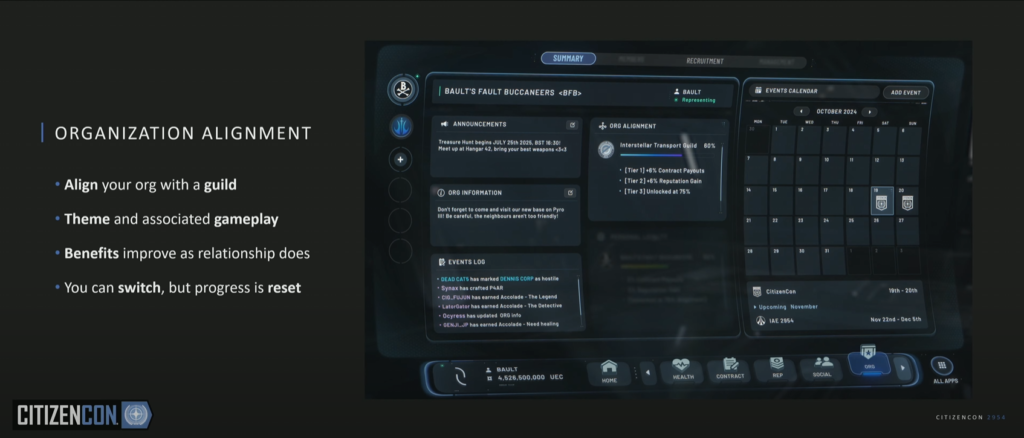
The screenshot above covers a lot of bases. It’s the “homepage” in-game for an org, showing MOTD, important announcements, an event log, and even a calendar which displays CIG-created server events and org created events.
Orgs can align with specific guilds. That means that if your org is focusing on cargo, then aligning with the Interstellar Transport Guild is a no-brainer. Aligning with a guild provides perks and benefits so while an org can operate without alignment, it’s basically leaving money on the table.
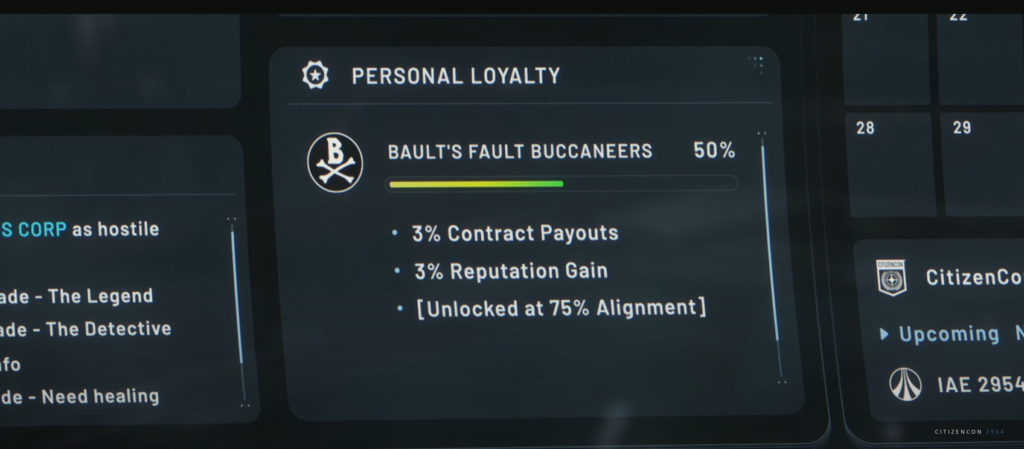
Players also have org alignment that can be affected by both what a player does within an org (such as contributing cash or materials to a building project) and what the player does for the org’s aligned guild. A player’s loyalty to their org will gate the quantity of benefits that they receive from the aligned guild. The above screenshot works with the previous screenshot: the aligned guild offers a 6% contract payout, but only to members with org loyalty of 100%. In the case of the screenshot above, as the player only has an org loyalty of 50%, they only get half the guild benefit. As with an org’s loyalty to a guild, a player who switches representation frequently will not earn rep as quickly as they would if they stuck with a single org. This also means that even if an org has a high rep with their guild, new members will not as they haven’t proven to be sufficiently loyal to their new org.
Org Management
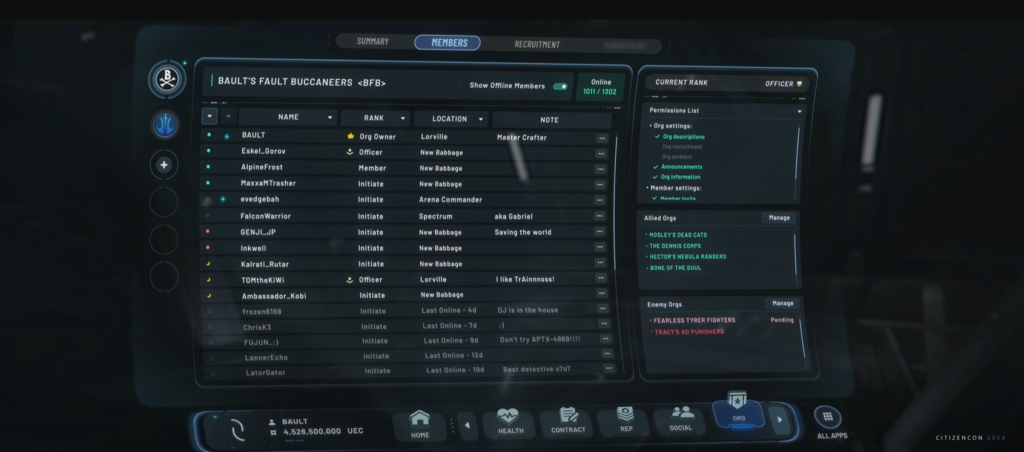
While this screen doesn’t show everything, it does show the org roster. Org members can be seen by name, rank, current location, and with a custom note. Org leaders can also set ranks, and those ranks can have a set of permissions covering what kind of mechanical actions a player of that rank can take within the org.
Of note is the list of allied and enemy orgs. Org leaders must reach a mutual agreement with each other to enter into an alliance. Allied org members will show up in game as friendly and will probably incur a severe penalty if an org member attacks an allied org member. Enemy orgs, however, only require one side to designate another org as an enemy, and once an org declares another org KOS, they will show up as red regardless of criminal status..
Thoughts
As the folks on stage said at the outset, the goal of this presentation wasn’t to shake the foundations of online multiplayer tools. Star Citizen’s social tools are some of the oldest in the game right now (dev claim) and with server meshing on the horizon, are going to need a boost real quick. Bringing the social tools up to a minimally viable MMO standard is important.
The friend list revamp is important — although it does remove local ATC from the list, which I still have to use sometimes to get a landing pad so hopefully that system will get an update elsewhere to make it more reliable. Adding party management there is also important. Having a list of ships in the party, as well as who is in what ship and at what station is pure voyeuristic gold, though, and can be helpful in spreading out party members or knowing if a drop-ship is under capacity for the pending operation.
FOIP and VOIP are low-rent additions, IMO. For those who really want the immersion, VOIP can be very useful; I know our org has used it in the past on occasion. Being able to hear and talk to nearby players can also be fun, but also dangerous if it’s a hot mic and players are trying to sneak up on other players. FOIP is less exciting and is really only useful if a player is using VOIP because if I’m not, and I start talking on Discord or to my wife, seeing my character’s facial emotes is going to be really…dumb. But as a tool for creating in-game movies, I am absolutely on board with having this as a feature.
I am still on the fence about the guides system. On one hand, it’s an improvement over the current method of signing up as or finding a guide. I don’t know how often this system is currently used, though, so I can’t say whether or not this is a solution in search of a problem. As I mentioned above I can understand that Star Citizen, as complex as it is, has a steep learning curve and players helping players just inherently makes the game better. I do think that CIG’s over-engineering of the ratings system could be a good way to ensure that players who want to help or be helped know what they’re getting into. It’s one pillar of trying to codify the means of “keeping players honest”, and no MMO has ever found the magic bullet that ensures that good behavior is rewarded and bad behavior receives an actual, real, meaningful punishment. This rating system is a nice way of putting information about player behavior in the hands of those who need it, without resorting to mechanical methods that players have a knack for circumventing. We’ll have to see how well it plays out in practice, though.
The info about orgs presented in this segment is really only part of the overall org-centric content that dropped this CitizenCon. While they talked about the UI, management, and guild affiliations, they said nothing about the mechanics of being in an org. What does having ranks and permissions mean? What about the off-handed comment regarding “guild storage”? As of today, I have not been overly active in my org outside of the occasional comment in the Discord. Part of the reason is because only some members are active, and are in “boredom mode”, opting to camp out at PvP hotspots to attack other players who arrive to sell drugs and such, and that’s not for me. However, with server meshing and an expanded pool of members online at any time who are doing all kinds of other things, I hope to participate more as it will require less coordination when A) everyone is on the same server and B) we have in-game tools to foster more immediate jump-in scenarios that require scheduling or sign-ups before anyone is even in the game.
Speaking of which, it was also mentioned that a lot of this info — presence info such as where players are in the game (city, planet, ship, etc), what they are doing (missions, in party, etc), and chat — will be available from outside the game client as well. Even in 2024, this kind of meta-system is absent in the online gaming space. I know WoW tried it but I don’t know how often it was used, and I know EVE had something similar (not sure if it still does) but I think for a game like Star Citizen which fosters gameplay which can involve a lot of people with requirements for roles and which can make a wider swath of people happy in doing so really benefits from getting in-game info outside of the game so that org members can keep up with what’s going on and feel connected even when they aren’t in the game at the same time.



